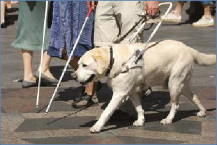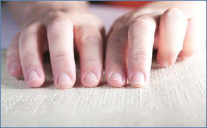< Previous | Contents | Next >
Visual Disability

Visual disabilities vary greatly. Persons are considered legally blind when visual acuity is 20/200 or less in the better eye with the use of corrective lenses, or when they have a field of vision no greater than 20 degrees. Most students who are legally blind may have some vision. Others
who are partially sighted may rely on residual vision with the use of adaptive equipment. Students who are totally blind may have visual memory, depending on the age when vision was lost. Some blind students may need to use a service dog to assist them to get around campus. These dogs are specially trained and are allowed in classrooms and other academic settings.
Functional Limitations
Students with visual disabilities face the challenge of accessing information designed for a visual world delivered in visually oriented forms and systems. These can include printed materials and books, graphical computer interfaces, and online video. Other activities impacted by visual impairments include:
Transportation and mobility
Reading laboratory devices and taking measurements
Reading signage and room numbers
Reading print materials, textbooks, and computer-based information
Comprehending mathematical symbols and concepts
Accommodations
Accommodation needs of students with visual disabilities vary greatly by individual and academic activity. Some common accommodations provided include:
Preferential classroom seating
Audio recording of lectures
Note-takers, scribes, and lab assistants
Sighted assistance with group activities
Use of canes or service animals for mobility
Alternate formats of printed materials and texts
Assistive technologies such as screen enlarging or reading software
Extended time on exams
Teaching Strategies

Provide reading lists or syllabi in advance to allow time for ordering electronic versions of textbooks and other reading materials or for scanning or brailing of texts
Provide in advance a list of videos that will be used in class or assigned, to enable private viewing with a video describer
Consult with the students and the disability services staff to identify effective adjustments for students with visual disabilities in web-based or hybrid courses
Assist the student, in cooperation with the disability services staff, in finding readers, note-takers, or tutors, as necessary, or team the student with a sighted classmate or laboratory assistant
Reserve front seats for low-vision students (if a guide dog is used, it will be highly disciplined and require little space)
Face the class when speaking
Convey in spoken words whatever you put on the board or project on a screen and any other visual cues or graphic materials you may use
Permit lectures to be taped and/or provide copies of lecture notes, when appropriate
Provide print documents in large fonts and/or provide electronic copies
Be flexible with assignment deadlines
Plan field trips and such special projects as internships well in advance, and alert field supervisors to whatever adaptations may be needed
Consider an alternative assignment if a specific task is impossible for the student to carry out
Consider alternative means of assessment, such as oral exams, audiotaped exams, large print paper, Braille embossed or tactile materials versions of exams, electronic formats of exams readable by screen reader and magnification software. Other adaptations suited to specific instructional situations may be appropriate in presenting diagrams or illustrations in certain subjects
Additional useful tips and practices for faculty working with visually impaired students can be found here
Our Sources and Additional Resources:
NYS Commission for the Blind and Visually Handicapped:
http://ocfs.ny.gov/main/cbvh/faq.asp
Adaptive Technology Center for New Jersey Colleges:
http://adaptivetech.tcnj.edu/resheet/blind.htm
American Foundation for the Blind (AFB):
http://www.afb.org/ProdBrowseCatResults.asp?CatID=49
http://www.afb.org/ProdBrowseCatResults.asp?CatID=39
Online resources for teaching the Blind:
http://www.uni.edu/walsh/blindresources.html
< Previous | Contents | Next >


